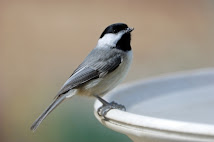Attracting Birds to your Neighborhood
There are a number of ways to attract birds to your garden, from planting native plants to providing safe stopover areas for them to eat, drink and nest.• Provide
water year-round - A simple birdbath is a great start. Change water every 2-3
days in summer and use a heater in the winter. Place the water container about
10 feet from dense shrubs or other cover that predators may use.
• Install
native plants - Select a variety of native plants to offer year-round food in
the form of seeds, berries, nuts, and nectar. Try to recreate the plant
ecosystem native to your area. Evergreen trees and shrubs provide excellent
cover through all seasons, The Lady Bird Johnson Wildflower Center as well as
the St Louis Audubon Society has lists of recommended native plants by region
and state.
• Eliminate
insecticides in your yard - Insects are the primary source of food for many
bird species and are an important source of protein and fats for growing
juvenile birds.
• Keep dead
trees - Dead trees provide cavity-dwelling places for birds to raise young and
as a source to collect insects for food. Many species will also seek shelter
from bad weather inside these hollowed out trees.
• Put out
nesting boxes - Make sure the boxes have ventilation holes at the top and
drainage holes below. Do not use a box with a perch, as house sparrows are
known to sit on a nesting box perch and peck at other birds using the nesting
box. Be sure to monitor the boxes for invasive animal species known to harm or
out compete native species.
• Build a
brush pile in a corner of your yard - Start with larger logs and top with
smaller branches. Some birds will hunt, roost or even nest in brush piles.
• Offer food in feeders - Bird feeders are great sources of supplemental food during times of food scarcity, and also enhance bird viewing opportunities. Wintertime is beneficial for this, as natural sources of pods and seeds become scarce.
• Remove
invasive plants from your wildlife habitat - Many invasive plants out-compete
the native species favored by birds, insects and other wildlife. Check with
your local U.S. Department of Agriculture Cooperative Extension System office
for information on plant species to avoid.
• Reduce your lawn area - Lawns have little value to birds or other wildlife, and they require more energy for mowing, applying fertilizers and watering.
See you in the garden,
Sandi
















